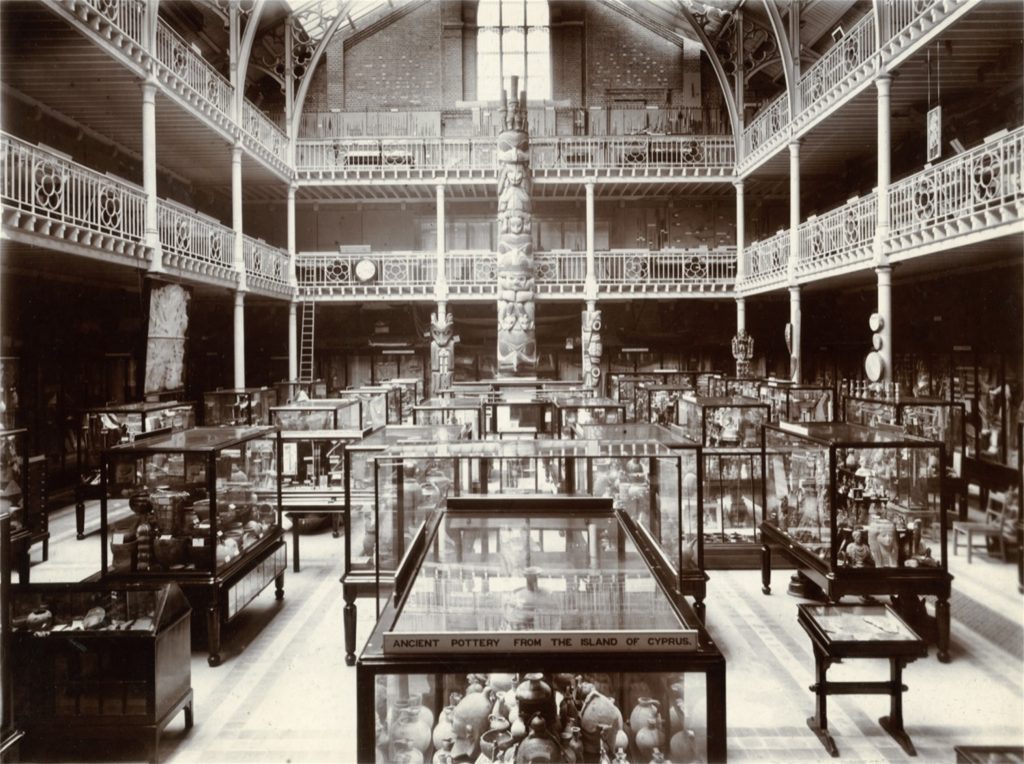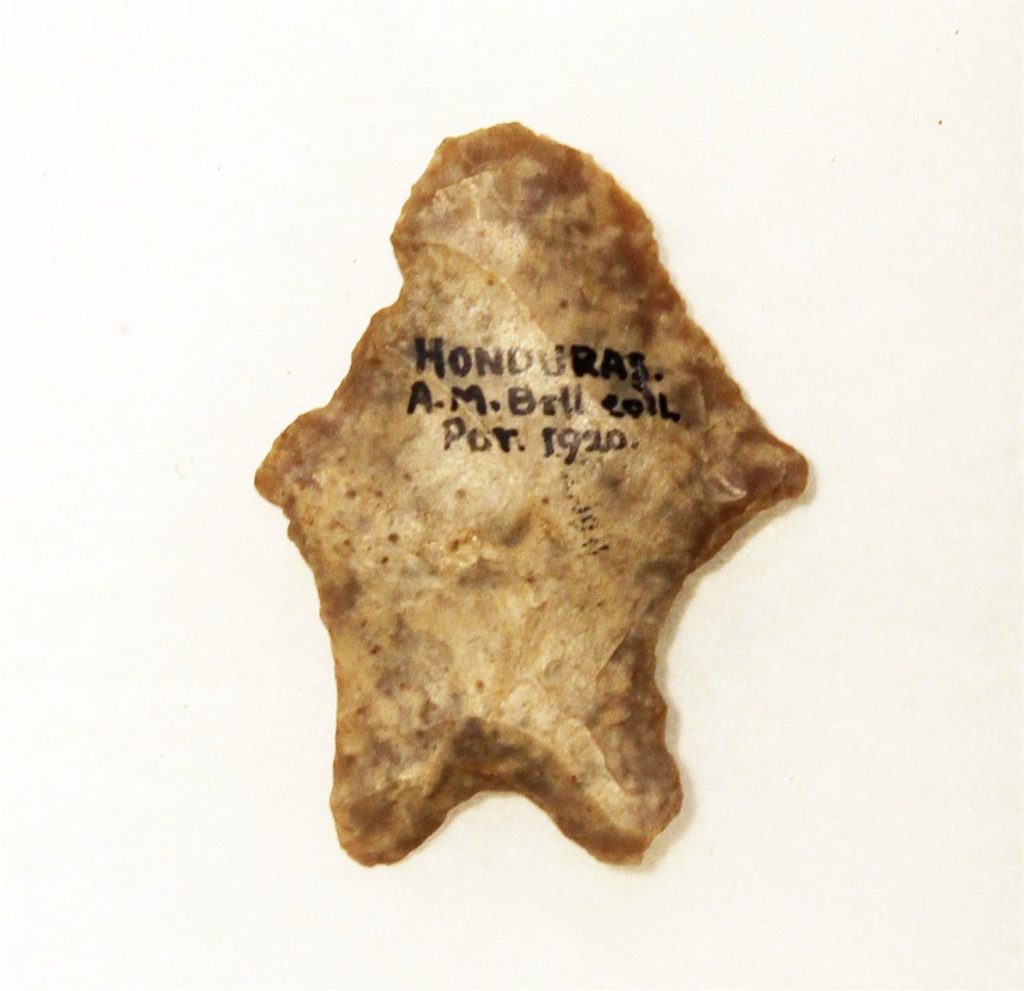Stone Points to a Connected World

I was sitting in the brightly lit workroom at the Pitt Rivers Museum on a frigid day in November 2010, when I opened one of the bags that my hosts brought me. My review of museum records had identified 21 objects associated with Honduras, where I have worked for more than 30 years. Five were old photographs and postcards; two were bark-cloth objects collected in 1921 from an Indigenous community. My interest was in the remaining 14, all archaeological objects, either stone or plaster-cast copies. The largest was too big to be brought to the table; the smallest were enclosed in protective plastic bags.
The Pitt Rivers Museum, on the campus of the University of Oxford, in England, holds an eclectic collection of a half-million artifacts, donated by scientists, travelers, and missionaries over more than a century, and it’s hard to predict what treasures might be found in its vast storerooms. This particular small bag contained two objects.
I gasped as two stone points slid out onto the white lab table. Small enough to fit comfortably in the palm of my hand, each showed the traces of the work put into flaking its surface. At the base of each triangular point, notches were cut, giving these objects a shape suggesting a fish tail. The brown chert from which they were made—a type of smooth, compact rock, similar to glass, that easily breaks into facets—was not particularly distinctive.
However simple, these stone tools took my breath away. They were the first of this shape and size I had ever held in my hand, but I recognized what they were: stone tools made by the earliest known people in Honduras. The points echo those of similar size and shape recovered at two sites in the mountains of southern Honduras. A similar point was collected near the city of La Esperanza, where an obsidian source was used for millennia by Indigenous Honduran people. Seven points similar in shape, made of chert, were excavated at the Cueva del Gigante, a natural cavity in the rock face used as a shelter by ancient Honduran people for thousands of years.
The sites around La Esperanza, which were found by archaeologists walking through fields and on rises in the high mountains of southwest Honduras, are located in an area where ancient volcanic eruptions formed patches of obsidian—natural glass. Archaeologists see evidence there of where obsidian was quarried in shallow pits and streams. Some ancient miners simply carried off the workable stone, while other visitors, using rock hammers and punches made of wood, bone, or antler, crafted the obsidian into distinctive shapes—long narrow blades, scrapers, and large ovals like spear heads—right there.
Cueva del Gigante is also located in the high mountains, but is a shallow cave containing deep deposits left by generations of ancient peoples sheltering there. The points from the Cueva del Gigante date between 8,000 and 1,000 B.C., the earliest period of known human habitation in Honduras.
The two points lying in front of me in England had just raised the known number of these ancient artifacts, most likely used for hunting, by 25 percent. But how did they end up at the Pitt Rivers Museum? The story of these important objects soon came to epitomize for me the labyrinthine realm of museum collecting that depended on a world connected by trade.
Augustus Pitt Rivers was a 19th-century British soldier who became fascinated by archaeology during deployments overseas. In 1884, he donated his entire 22,000-object collection to Oxford to establish the museum that bears his name. Pitt Rivers was deeply interested in the development of technology at a global scale. He famously arranged objects from different cultures in series to show the development of weapons and other tools over time and their variation across neighboring regions. The result is a museum full of glass cases, objects in rows on shelves in order of shape—not culture, place, or ethnic group of origin (as we typically see in today’s museums). Cases have titles like “Human Form in Art” and “Treatment of the Dead.” A set of cases titled “Smoking and Stimulants,” with “Smoking Pipes and Lime Vessels” on one end and “Smoking—Water Pipes” on the other, is crammed full of wood, glass, and metal objects used to smoke tobacco. The next generation of curators at the museum continued collecting in the tradition of Rivers.
I was at the Pitt Rivers as part of a project to understand the way that objects from the Americas made their way to distant lands and ultimately, into museums. In 2010 and 2011, I visited a series of museums in Europe where I had reason to think there were objects from Honduras. My research led me to Berlin, Genoa, Paris, London, Manchester, and Oxford, and along the way, I learned about other collections in additional museums. For some of these museums, I knew of the objects from articles published in the 18th and 19th centuries. In other cases, my ability to track these objects down depended on the creation by contemporary museum specialists of new websites, where anyone in the world can browse records, and often photographs, of objects in the collections. That was the case with the Pitt Rivers Museum, a leader in making its museum accessible through the Internet. But the online records for Honduras did not include photographs of these two unassuming points.
Perusing the records the museum had for these two objects, I learned that they came from Alexander James Montgomerie Bell, a British classics scholar who also devoted his energy to collecting stone tools from sites around England. Bell’s son sold the collection to the museum in 1921.
How these two stone points from Honduras ended up in Bell’s possession was a mystery. Bell had never been to Central America. Research in this remote part of Honduras by academic archaeologists in the 20th century started quite late. The first archaeological report on the area was published in 1963. How did these points reach Bell?
How these two stone points from Honduras ended up in Bell’s possession was a mystery.
My research on early museum collecting in Central America suggests a possible answer. Many archaeologists in 19th-century Europe used the same kind of formal comparison of artifacts by shape and technology as Pitt Rivers. One of the hot topics of that time period was the arrival of humans in England during the Paleolithic—the “old stone age”—and stone tools provided the primary evidence. Time after time, I found that old collections from participants in debates about the Paleolithic included, for comparison, one or two chipped stone tools obtained in Central America.
One source for such objects in European museums appears repeatedly in museum records: Bryce McMurdo Wright Sr. A mineral dealer in the 1840s who sold and even rented out specimens for lectures, his clients included major collectors, not least of which was the British Museum. Having started life as a miner, Wright Sr. drew on a network of sources that included miners and naturalists in the Americas. After Wright Sr.’s death in 1874, his son carried on the business. In 1880, Wright Jr. advertised, among other minerals, opals from Honduras, prized products of the same mountainous region that is home to the La Esperanza and Cueva del Gigante sites. In 1888, following Wright Jr.’s bankruptcy, his creditors held an auction of his remaining holdings, including stone tools.
This evidence points to the possibility that Alexander Bell, the collector of ancient stone tools, purchased from the Wright auction these two brown chert points, which were subsequently donated to the Pitt Rivers Museum. While we don’t yet know for sure, something like this had to have happened.
This history shows a connected world: how a 19th-century classics teacher who lived all his life near Oxford could have come to possess stone tools that are examples of the earliest known stone-tool tradition from Honduras. The 19th-century world was already networked. Signs of this globalization can be found in the unlikeliest of things and places—such as two ancient stone points sitting in a museum storeroom.


























